|
Wednesday, May 21
- Breakfast: breakfast pizza
- Breakfast: ham, egg and cheese English muffin
- Gyro
- Smart cuisine: baked pork chops
- Chicken cacciatore
- California turkey wrap
- Chicken carbonara
- Three-bean overland soup
- Texas-style chili
- Assorted calzones
Wilson Hall Cafe menu |
|
Wednesday, May 21
Lunch
- Spinach- and red pepper-stuffed chicken breast
- Orzo salad
- Strawberry shortcake
Friday, May 23
Dinner
Closed
Chez Leon menu
Call x3524 to make your reservation.
|
|
Jim Hirschauer receives DOE award to search for supersymmetry
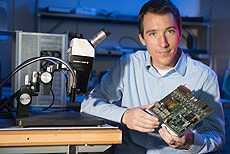 |
Fermilab scientist Jim Hirschauer was one of 35 researchers selected for the 2014 DOE Early Career Research Award. Photo: Reidar Hahn |
The search for something new is about the long game. One prepares for every eventuality when seeking out something whose very existence, though possible, is uncertain. One such quarry is supersymmetry, and although scientists can't be sure they'll find it, the excitement of unearthing new phenomena drives them to look.
Fermilab's Jim Hirschauer is one of the scientists on the hunt. Earlier this month, DOE announced that it selected Hirschauer for a $2.5 million Early Career Research Award to look for supersymmetric particles at the Large Hadron Collider's CMS experiment. Hirschauer is one of 35 researchers selected from a pool of about 750 applicants.
"We want to see what's next," said Hirschauer, who is also a 2013 Wilson fellow. "Our current theory works incredibly well for much of what we see, but there are several ways, famously, that it doesn't. We'd like to understand why, and there's reason to think that the solution to these issues might be accessible at the Large Hadron Collider."
Supersymmetry is the theory that the Standard Model, our best picture of how the universe works, is only half the story. Supersymmetry says that every particle in the Standard Model has a corresponding supersymmetric particle yet to be discovered.
The principle is attractive to scientists because it would tie up serious loose ends in our understanding of how the universe hangs together. If supersymmetry bears out, it would explain why the mass of the Higgs boson is as small as it is and how the universe's four forces are really different aspects of a single force. It would also get us closer to a good, working description of dark matter.
The search for supersymmetry at CERN's Large Hadron Collider, which is currently being upgraded to collide protons at almost double its previous energy, has thus far turned up empty. But when the machine turns on again in 2015, scientists will have that much more energy to mine. Its high-energy particle interactions create sprays of particles, among which could be lurking supersymmetric candidates.
If they're out there, researchers hope to be able to call them out, armed with a dossier of possible interaction profiles that could show up in the CMS detector. Some of the profiles would be easier to identify than others.
"We need to be ready in case it's there and obvious," Hirschauer said. "Then we'll be thrilled because we'll have the next decade or so to study it in great detail at the collider."
Read more
—Leah Hesla
|
The search for dark matter at the LHC
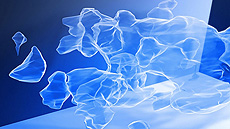 |
When the Large Hadron Collider restarts, it will be an even more powerful dark-matter-hunting machine. Image courtesy of NASA, ESA and R. Massey, California Institute of Technology |
Experiments at the Large Hadron Collider specialize in the discovery of previously undetected particles. So of course they are on the hunt for one of physics' most coveted prizes: dark matter.
Dark matter outnumbers visible matter — the kind of matter that makes up the Earth, the stars and all of us — five-to-one. Astronomers have seen its effects, and many experiments are working to catch dark matter particles as they pass through the Earth. So far, no one has found it for certain.
At the LHC, however, "we're not depending on dark matter to find us," says University of Bergen physicist Heidi Sandaker of the ATLAS experiment. "We're trying to create it ourselves."
Read more
—Kathryn Jepsen and Ashley WennersHerron
|
Cosmic anniversary: 'Big bang echo' discovered 50 years ago today
From Space.com, May 20, 2014
Humanity's understanding of the universe took a giant leap forward 50 years ago today.
On May 20, 1964, American radio astronomers Robert Wilson and Arno Penzias discovered the cosmic microwave background radiation (CMB), the ancient light that began saturating the universe 380,000 years after its creation. And they did so pretty much by accident.
Bell Labs' Holmdale Horn Antenna in New Jersey picked up an odd buzzing sound that came from all parts of the sky at all times. The noise puzzled Wilson and Penzias, who did their best to eliminate all possible sources of interference, even removing some pigeons that were nesting in the antenna.
"When we first heard that inexplicable 'hum,' we didn't understand its significance, and we never dreamed it would be connected to the origins of the universe," Penzias said in a statement. "It wasn't until we exhausted every possible explanation for the sound's origin that we realized we had stumbled upon something big."
Read more
|
|
Fifty years of colliders
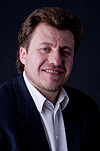 |
|
Vladimir Shiltsev
|
Vladimir Shiltsev, director of the Accelerator Physics Center, wrote this column.
This spring accelerator physicists celebrate the 50th anniversary of the first demonstration of colliding beams in 1964. The idea of exploring collisions in the center-of-mass system to fully exploit the energy of accelerated particles came from Norwegian engineer and inventor Rolf Wideröe, who had applied for a patent on the collider concept in 1943 (and received the patent in 1953).
Others took his idea seriously, and in the late 1950s, three teams started working on colliding beams. One was a Princeton-Stanford group that included William C. Barber, Bernard Gittelman, Gerry O'Neill and Burton Richter, who in 1959, following a suggestion from Gerry O'Neill in 1956, proposed to build a couple of tangent rings to study electron-electron scattering. Andrei Budker initiated a somewhat similar project in the Soviet Union, where electron-electron collider VEP-1 was under construction in 1958. An Italian group at Laboratori Nazionali di Frascati led by Bruno Touschek began a design of the first electron-positron collider.
In the early 1960s, almost at the same time, commissioning and operations of these first colliders began in Italy, the Soviet Union and the United States. The Italian group built the electron-positron storage ring ADA (Anello di Accumulazione). They worked hard through the spring and summer of 1964 to get enough statistical evidence for the first electron-positron collisions to be able to separate them from the background. The first electron-electron collisions in Novosibirsk, Russia, were detected on May 19, 1964, and in 1965 VEP-1 started providing the first experimental results. The Princeton-Stanford electron-electron collider announced its first electron-electron collisions in March 1965, and its first interesting results were published in 1966.
The race to first collisions between the competing groups set the tone for the development of Energy Frontier accelerators for the next 50 years. Fermilab was a leader in that area for almost 25 years with our Tevatron collider, which closed in September 2011.
We now have entered the race for operating the world's premier high-power accelerators for neutrino research and believe that with our planned PIP-II linac, the United States can lead Intensity Frontier research for decades to come.
|
In memoriam: David Wildman
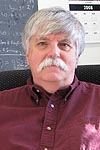 |
|
David Wildman
|
Fermilab employee David Wildman, 64, of Aurora, passed away Sunday, May 18.
Wildman received his bachelor's degree from MIT in 1972 and received his Ph.D. from MIT in 1976. He was a physicist at Fermilab in the Accelerator Division for more than 30 years.
He is survived by his daughter, Julie Wildman, and his mother, Arlene Wildman.
A celebration of life will be held at 11 a.m. on Friday, May 23, at Moss Family Funeral Home, 209 S. Batavia Ave., in Batavia. Visitation will take place from 10 a.m. until the time of service. Interment will be private.
In lieu of flowers, contributions in Wildman's memory may be directed to a charity of the donor's choice.
|
Blooming hepatica
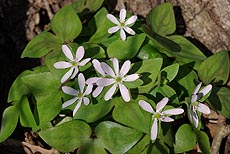 |
| Hepatica blooms on the Fermilab site. This flower is usually the first woodland flower to bloom. Photo: Barb Kristen, PPD
|
|
ESH&Q weekly report, May 20
This week's safety report, compiled by the Fermilab ESH&Q Section, contains one incident.
An employee tripped and fell on some wet steps in the north transfer gallery, hurting both knees. He received first-aid treatment.
Find the full report here.
|
|